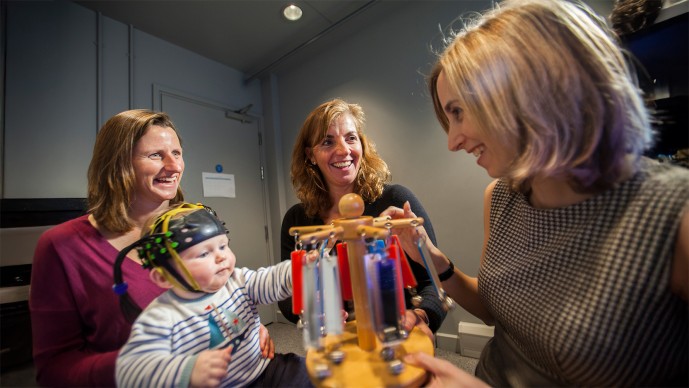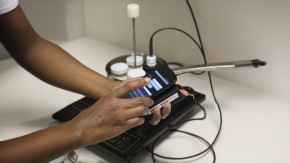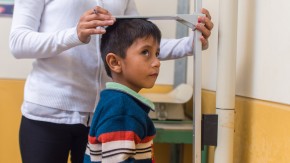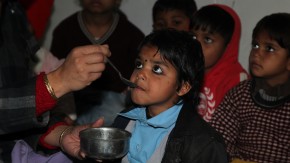Innovation: An Interdisciplinary Approach to Impact - Shedding New Light on Child Brain Development
- Trevor Mundel, Feb 14, 2017

Ten years ago, Warren Buffett donated the bulk of his fortune to the Bill & Melinda Gates Foundation. His generous commitment has allowed the foundation to dramatically expand the scope and impact of its work, and this year, Bill & Melinda Gates Annual Letter reports that Warren's gift has helped save 122 million lives.
It also takes a hard look at the challenges we must address to achieve the ambitious goal of ending preventable child deaths by 2030.
Given the incredible scientific advances we read about every day in field after field, it's stunning how little we still know about certain things. One of the fields where we have the most to learn is brain development.
This is not just an academic issue. Tens of millions of young children in poor countries won't reach their full cognitive potential. And while we're confident that factors like malnutrition play a significant role in this underdevelopment, there is still much we don't know about why, or when cognitive disabilities occur, or how to prevent it.
The current tools we have to address malnutrition in developing counties only solve for about half the estimated global burden of stunted growth and brain development. And we can't even measure child brain development optimally. By the time children are old enough to take standardized IQ or behavioral tests (such as whether they can catch a ball), the damage may already be done.
Dr. Clare Elwell, a professor of medical physics at University College London, has an idea that may help open up this black box around babies' brains—and, eventually, start driving down the number of children who are cognitively impaired.
What makes her work so surprising is that until recently, Elwell had never studied children in developing countries; in fact, she'd never done any global health research at all. She spent her time in her native England developing an optical brain imaging technique called functional near-infrared spectroscopy (fNIRS) that tracks brain activity by taking pictures of oxygen distribution in the brain. To do this, she uses a completely non-invasive technique that shines infrared light on the outer surface of babies' heads. These lights can read signals in babies' brains while they watch videos and listen to sounds. (You can see Professor Elwell demonstrating how it's done in this video.) If an area of the brain is activated by the video or sounds, then the increased oxygen levels are reflected as variations in blood color, and the imaging system records the change.
In 2011, researchers from the International Nutrition Group at the UK Medical Research Council Unit based in the Gambia, happened to read a paper Elwell had written about her research with children at risk of autism, and they got in touch. They knew she had only worked on babies in the UK, they said, but they thought that fNIRS might also help global health researchers understand the baffling problem of widespread cognitive impairment in developing countries. Would she consider adapting her equipment to help them track children from birth to age two in the Gambia? Elwell jumped at the opportunity and got a Grand Challenges Explorations grant to support the initial stages of her work.
The team's first step was to make sure that the technology and protocol that worked well in a high-tech lab in London would also work well in the heat and humidity of rural Gambia. They took as many precautions as they could: they brought a lot of spare equipment, and they packed everything with extreme care to make sure it survived the bumpy, three-hour drive from the nearest city to the field station. They even re-filmed their videos, using a Gambian child actor instead of a UK actor and replacing objects Gambian infants might never have seen, like toy airplanes, with more familiar objects.
Their careful preparation paid off: less than three hours after unpacking the equipment, they'd finished their first infant study, and before long they knew that fNIRS worked just as well in the Gambia as it did in London.
Now that they know they have a reliable tool, their real work begins: using it to bridge the huge gap in our understanding of childhood brain development. Their first project, undertaken with a cohort of 200 Gambian babies and 50 UK babies, is to create a standard trajectory against which to measure any baby's brain development. They hope, once they're done, to have a chart like the ones parents and doctors all over the world use to track babies' physical growth, but instead it will track brain function over the first two years of life.
Using the fNIRS technology to study children in developing countries can eventually help us start to understand why and when children get off track, a current priority for the foundation's Healthy Birth Growth and Development Initiative. The protocol Dr. Elwell's team has created measures not just babies' brains but also other variables in their lives—like family health and wealth, babies' physical growth, and how much social interaction the babies have and with whom.
Dr. Elwell's team will then be able to cross-reference these variables with each child's brain function to find the variables that seem to affect brain development the most. Gradually, these insights can be translated into strategies for helping babies' brains grow as they should. This project, one of several the foundation is supporting to develop new tools to assess child brain development, has gained interest from other researchers. Elwell's team is collaborating with Charles Nelson, who is using many of the same protocols to study infants living in poor neighborhoods of Dhaka, Bangladesh.
In both the Gambia and Bangladesh studies, the researchers are using multiple new methods of measuring the brain, including not only fNIRS but also a technique called electroencephalography, eye tracking, and traditional behavioral tests. This will help the researchers compare them and see which ones are best at revealing which kinds of information. What this means is that before long, we're going to have much more data than we've ever had, and we'll be able to look for correlations—and for locally appropriate solutions.
The number of babies in the world whose brains are underdeveloped is very hard to measure, but it might be as many as one in every three. Quite simply, these children will have a difficult time reaching their full potential without a new commitment to investing in the gray matter infrastructure of Africa and Asia. Developing better ways to analyze child brain development is an essential first step. If Dr. Elwell and her colleagues' work helps identify new high-impact interventions, it will play a key role in helping developing countries give all children the opportunity to lead a healthy and productive life.



